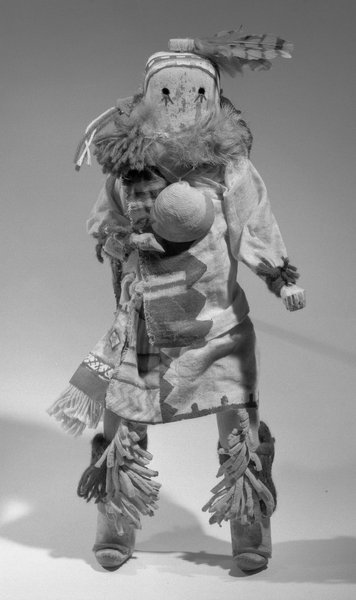Kachina Doll (Kjaklo) Item Number: 03.325.4614 from the Brooklyn Museum


Description
Stewart Culin provided the name Kjaklo for this particular kachina doll, which may not be accurate. Now identified as Kiaklo. Feathers are tied to the top of his head. His white face has painted dashes extending out from the bottom of each small eye in three different directions. On one side of his head is a small horn-shaped ear. The kachina is wearing a two-piece textile dress and sash, upon which are painted geometric designs. Around neck are a feather ruff and a disproportionately large shell amulet. Wrists are tied with colored yarn. In proper right hand is a small wooden bird- probably a duck. On kachina's feet are high, long-fringed leather boots, tied at the top with yarn. See the long story about Kiaklo in "Kachinas of the Zuni"pgs. 51-53.by Barton Wright. Involves Kiaklo searching for the middle, being counseled by Duck, and offering to guide him (he had become blind) if he put his shell around Duck. He appears every four years at the initiations of young boys ensuring they are initiated into the Kachina cult and preparing the way for the Salimopea and Kolowisi. The kachina doll is in stable and good condition; however, garment decorations reveal some paint losses. Leather is stiff and appears brittle.
Credit Line
Museum Expedition 1903, Museum Collection Fund
Label
These Native American objects represent just a few of the items made in the late nineteenth and the early twentieth century, primarily for sale to dealers and collectors to satisfy the growing market for indigenous products. Finely coiled baskets like the example by the Maidu weaver Mary Kea’a’ala Azbill were in great demand, as were Zuni Kachina dolls. The desire for Eskimo objects such as the ivory pipe engraved with a whale-hunting scene was accelerated by the Klondike Gold Rush in 1897. To appeal to non-Native patrons, Native artists invented new designs using trade materials such as the glass beads forming the embroidered floral arrangement on the northeastern puzzle bag (so named for the way its pieces fold together to keep it closed). Other artists used traditional materials but tailored designs to non-Native aesthetics, as seen in the porcupine-quill box. The Navajo quickly adapted to the Spanish introduction of silver coins and silver mining in the seventeenth century, embellishing their traditional wrist guards with hammered silver. Some artists retained both traditional materials and designs but produced greater quantities of popular items such as the Plains owl pipe bowl made from Catlinite (red pipestone).
Item History
- Made between 1868 and 1899
What
Who
- Culture
- She-we-na
Where
- Holding Institution
- Brooklyn Museum
When
- Creation Date
- between 1868 and 1899
Other
- Classification
- Sculpture